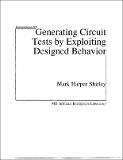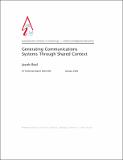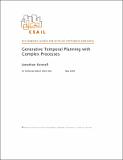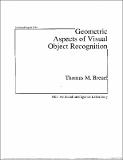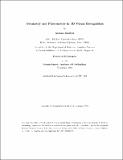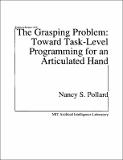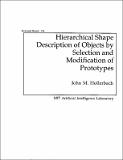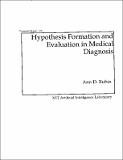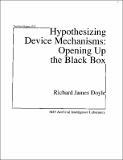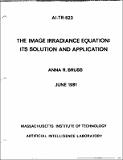Browsing AI Technical Reports (1964 - 2004) by Title
Now showing items 105-124 of 327
-
Gait Analysis for Classification
(2003-06-26)This thesis describes a representation of gait appearance for the purpose of person identification and classification. This gait representation is based on simple localized image features such as moments extracted from ... -
Generalizing on Multiple Grounds: Performance Learning in Model-Based Technology
(1989-02-01)This thesis explores ways to augment a model-based diagnostic program with a learning component, so that it speeds up as it solves problems. Several learning components are proposed, each exploiting a different kind ... -
Generating Circuit Tests by Exploiting Designed Behavior
(1988-12-01)This thesis describes two programs for generating tests for digital circuits that exploit several kinds of expert knowledge not used by previous approaches. First, many test generation problems can be solved efficiently ... -
Generating Communications Systems Through Shared Context
(2002-01-01)In a distributed model of intelligence, peer components need to communicate with one another. I present a system which enables two agents connected by a thick twisted bundle of wires to bootstrap a simple communication ... -
Generating Compliant Motion of Objects with an Articulated Hand
(1985-06-01)The flexibility of the robot is the key to its success as a viable aid to production. Flexibility of a robot can be explained in two directions. The first is to increase the physical generality of the robot such that ... -
Generating Semantic Descriptions From Drawings of Scenes With Shadows
(1972-11-01)The research reported here concerns the principles used to automatically generate three-dimensional representations from line drawings of scenes. The computer programs involved look at scenes which consist of polyhedra ... -
Generative Temporal Planning with Complex Processes
(2004-05-18)Autonomous vehicles are increasingly being used in mission-critical applications, and robust methods are needed for controlling these inherently unreliable and complex systems. This thesis advocates the use of model-based ... -
Geometric Aspects of Visual Object Recognition
(1992-05-01)This thesis presents there important results in visual object recognition based on shape. (1) A new algorithm (RAST; Recognition by Adaptive Sudivisions of Tranformation space) is presented that has lower average-case ... -
Geometry and Photometry in 3D Visual Recognition
(1992-11-01)The report addresses the problem of visual recognition under two sources of variability: geometric and photometric. The geometric deals with the relation between 3D objects and their views under orthographic and ... -
A Government-Binding Based Parser for Warlpiri, a Free-Word Order Language
(1987-01-01)Free-word order languages have long posed significant problems for standard parsing algorithms. This thesis presents an implemented parser, based on Government-Binding (GB) theory, for a particular free-word order ... -
The Grasping Problem: Toward Task-Level Programming for an Articulated Hand
(1990-05-01)This report presents a system for generating a stable, feasible, and reachable grasp of a polyhedral object. A set of contact points on the object is found that can result in a stable grasp; a feasible grasp is found ... -
Heterogeneous Multi-Robot Cooperation
(1994-02-01)This report addresses the problem of achieving cooperation within small- to medium- sized teams of heterogeneous mobile robots. I describe a software architecture I have developed, called ALLIANCE, that facilitates ... -
Heuristics for Job-Shop Scheduling
(1988-01-01)Two methods of obtaining approximate solutions to the classic General Job-shop Scheduling Program are investigated. The first method is iterative. A sampling of the solution space is used to decide which of a collection ... -
A Hierarchical Cache Coherent Protocol
(1992-09-01)As the number of processors in distributed-memory multiprocessors grows, efficiently supporting a shared-memory programming model becomes difficult. We have designed the Protocol for Hierarchical Directories (PHD) to ... -
Hierarchical Object Recognition Using Libraries of Parameterized Model Sub-Parts
(1987-05-01)This thesis describes the development of a model-based vision system that exploits hierarchies of both object structure and object scale. The focus of the research is to use these hierarchies to achieve robust recognition ... -
Hierarchical Shape Description of Objects by Selection and Modification of Prototypes
(1975-11-01)An approach towards shape description, based on prototype modification and generalized cylinders, has been developed and applied to the object domains pottery and polyhedra: (1) A program describes and identifies pottery ... -
Hypothesis Formation and Evaluation in Medical Diagnosis
(1975-01-01)This thesis describes some aspects of a computer system for doing medical diagnosis in the specialized field of kidney disease. Because such a system faces the spectre of combinatorial explosion, this discussion concentrates ... -
Hypothesizing Device Mechanisms: Opening Up the Black Box
(1988-06-01)I describe an approach to forming hypotheses about hidden mechanism configurations within devices given external observations and a vocabulary of primitive mechanisms. An implemented causal modelling system called ... -
Image Chunking: Defining Spatial Building Blocks for Scene Analysis
(1987-08-01)Rapid judgments about the properties and spatial relations of objects are the crux of visually guided interaction with the world. Vision begins, however, with essentially pointwise representations of the scene, such ... -
The Image Irradiance Equation: Its Solution and Application
(1981-06-01)How much information about the shape of an object can be inferred from its image? In particular, can the shape of an object be reconstructed by measuring the light it reflects from points on its surface? These questions ...



